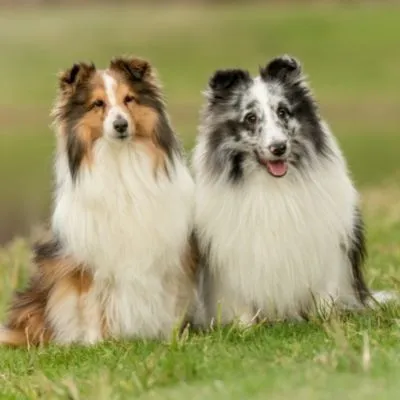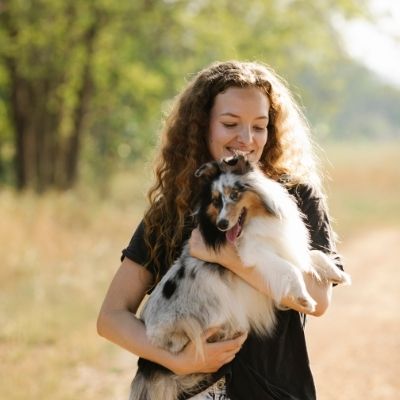Shetland Sheepdogs are known for their hypoallergenic coat and their calm disposition, which makes them good candidates for allergy sufferers and people with dog allergies.
They don’t shed much, but they are still dogs, and will occasionally leave hair on your clothes, sheets, and furniture.
They also need regular grooming, which will help keep their coats shiny and clean. Shetland Sheepdogs are small dogs, usually weighing between 14 and 20 pounds.
Sheltie History
The Shetland Sheepdog, also known as the Sheltie, was bred on the northern shores of Scotland to help farmers keep annoying critters out of their gardens and to help herd farm and field animals.
These small affectionate dogs originally descended from the Scottish Collie and King Charles Spaniel, and Pomeranian. Later, characteristics of the Rough Collie were added to this breed.
There is evidence that this breed also is related to the Spitz. The Shetland Sheepdog first appeared in the United States around 1908 and enjoyed continued popularity through the 1990s.
The Sheltie is a controversial breed that produced differing opinions between England and the United States on what breed characteristics truly define a true Sheltie.
Sheltie Characteristics
The Sheltie is an extremely intelligent, active little guard dog that stands 13 to 16 inches tall and weighs between 11 and 24 pounds.
Shelties are nimble, quick animals that were bred to work. So, they need to be given tasks and plenty of exercises to feel mentally and physically content.
An effective way to meet this need is by playing a game of frisbee or fetch for 30 minutes to an hour each day. This breed would make a good partner if you were someone who likes to take a brisk walk or daily jog.

Sheltie Personality
Out of over a hundred breeds assessed, the Shetland Sheepdog is ranked as the sixth highest breed for intelligence. This accounts for shelties being very trainable with the ability to learn new tasks within only 5 or 6 repetitions.
They are bred to be herd dogs so do not be surprised if you notice your dog attempting to corral you and members of your family. Shelties are companion dogs.
Their favorite pastime is shadowing their favorite person. They are very vocal dogs that bark to alert you of intruders or the arrival of guests. These dogs like the sound of their voice.
You will notice your Sheltie howling or “singing.” It is important to train your dog, early on, to limit its barking to one or two barks when alerting you.

Sheltie Grooming and Care
The most striking feature of this breed is its long, lush, tri-colored coat. This coat consists of a soft, thick undercoat that provides warmth during colder weather and a longer, water-repellent rougher outer guard coat that provides shade during the warm seasons.
Potential owners wonder, “Do Shelties shed and how often?” The Sheltie sheds continuously and requires grooming every 4 to 8 weeks.
Daily brushing with a pin brush is necessary to minimize random tufts of hair blowing around the house or covering the sofa. Never dry brush a Sheltie’s fur. Use a spray bottle to dampen its coat to prevent breakage.
Gentle daily brushing can increase the bond between you and your Sheltie. This activity increases trust and affection between dog and owner while keeping your Shelties coat and skin healthy and beautiful.
While brushing it is important to pay special attention to behind the ears, under the front and back legs, and around the area where a collar may be worn to prevent mats from forming.
Mats can be very painful to your dog while attempting to comb them out. This makes your special bonding timeless and pleasurable for both the dog and the owner.

The Sheltie has two major shedding seasons, Spring and Fall. Female Shelties will shed before or after birthing a litter of pups. Due to hormonal changes after spaying/neutering, the Sheltie’s coat may become softer and thicker in texture, therefore more easily matted.
While other dog breeds shed singular hair making it difficult to collect and dispose of, Shelties shed in clumps that you can brush out or pluck out by hand making clean-up a less difficult project. An unsprayed female will shed after each estrus menses.
While bathing a Sheltie, first give an initial cleanse to remove superficial dirt and debris. Follow up with a second shampoo and rinse that addresses any skin condition or allergy.
After a good rinse that removes all the shampoo from the skin and hair, use a superior conditioner to keep your Shelties coat beautiful and protected.
During the major shedding times, you can use products that help your dog easily and thoroughly shed its undercoat.
Fortunately, there are a variety of brushes, grooming gloves, and superior quality shampoos and conditioners that can make grooming your Sheltie a breeze.
Shaving a Sheltie is not recommended because it causes damage to the skin and may prevent hair from growing back. The Shetland Sheepdogs’ fur also provides important protection from the elements.
How do you stop a Sheltie from shedding?
This question is asked by both, potential and current Sheltie owners. The short answer is you cannot. The long answer is through daily maintenance of your Sheltie’s beautiful coat, you can minimize shedding and increase the bond between you and your pet.
It is important to be aware that some medical conditions can increase shedding. Hypothyroidism, fungal infections, and parasites are among the most common skin conditions that increase shedding in your pet.
Unfortunately, many Shelties are abandoned by their owners at animal shelters because they were unaware of the amount of hair Shetland Sheepdogs shed or are unable or unwilling to invest the time to properly care for their Sheltie’s coat.
This is an example of why you should do your research before purchasing or adopting an animal. Being an uninformed owner brings hardship to not only you but also the pet that you are bringing into your home.
It is important to take the time to decide how much of your time and energy you are willing to invest in a new pet. Then narrow down what breed is more suited to your lifestyle and personality.